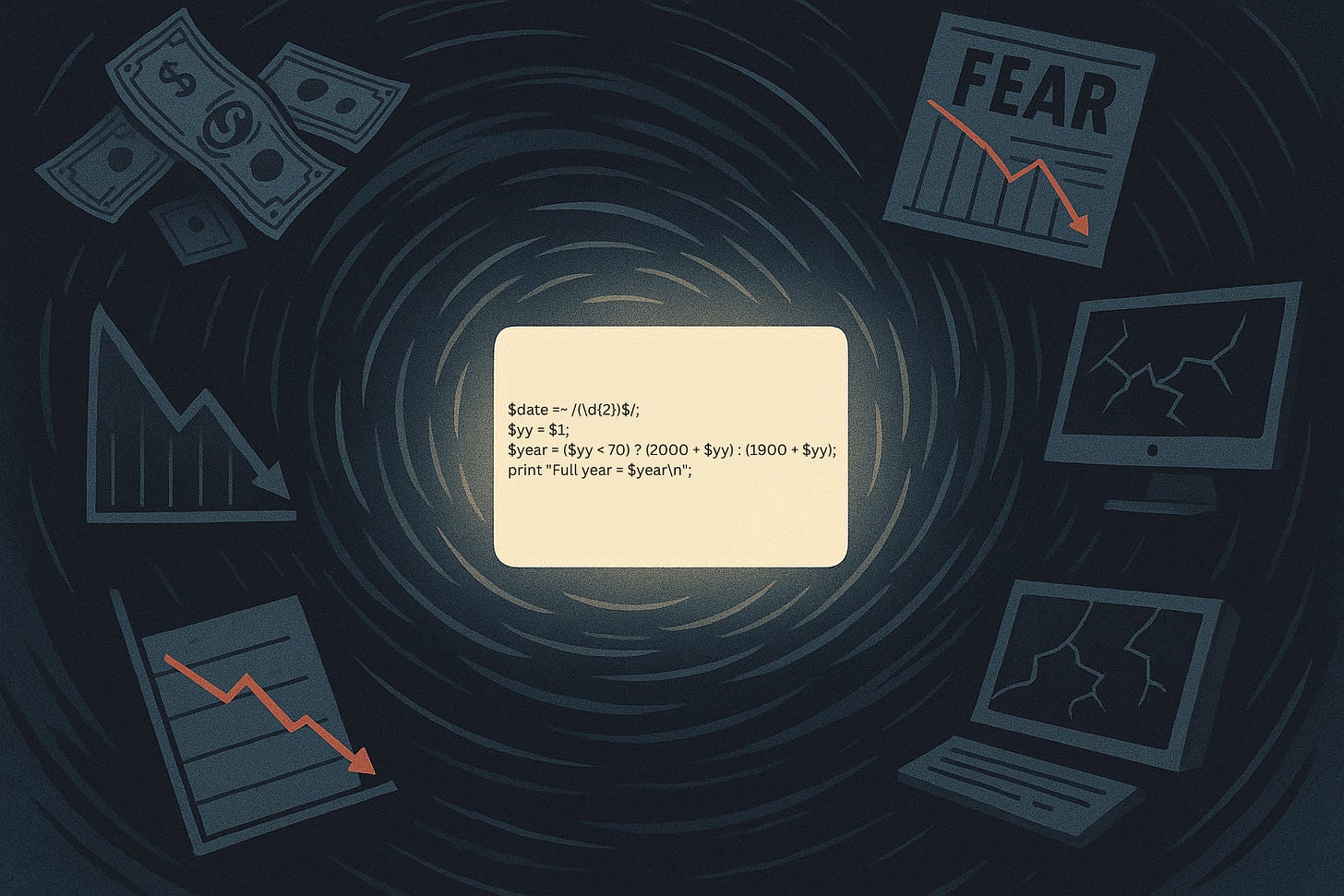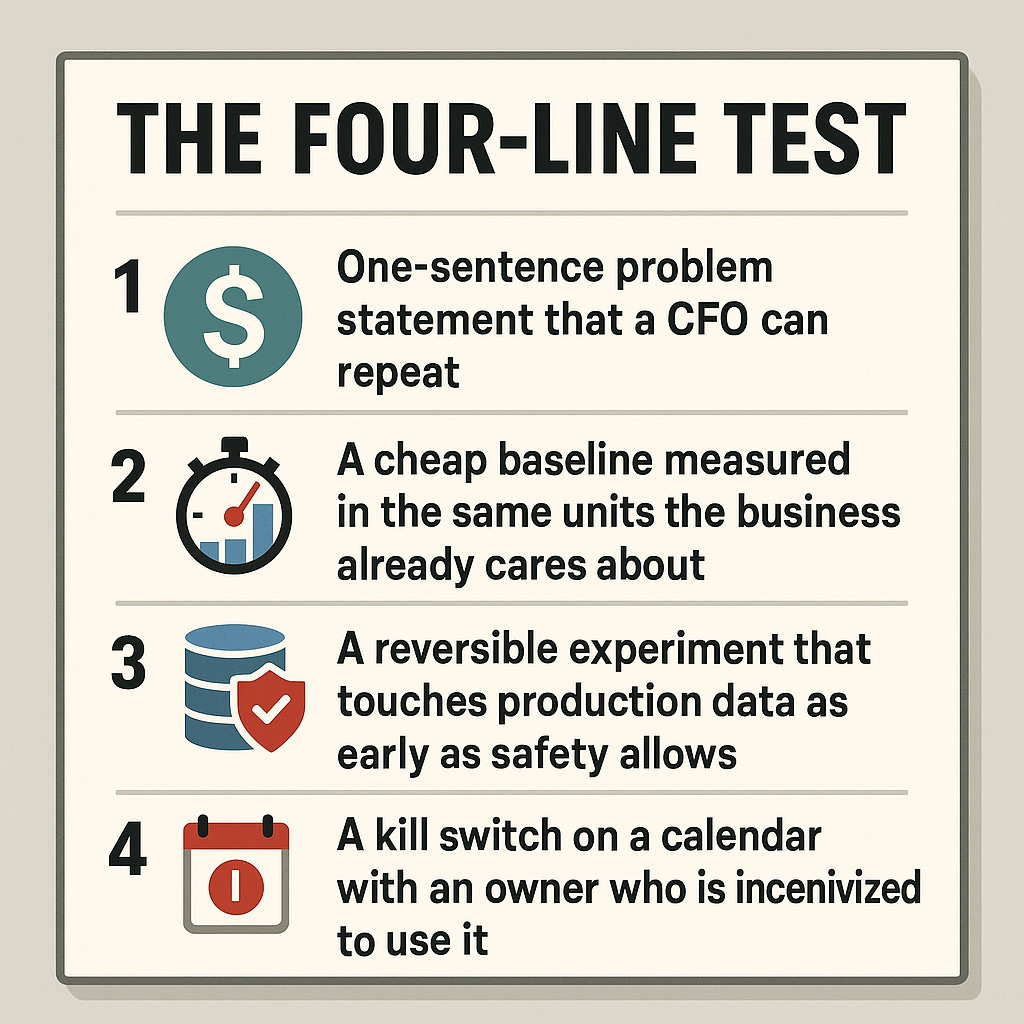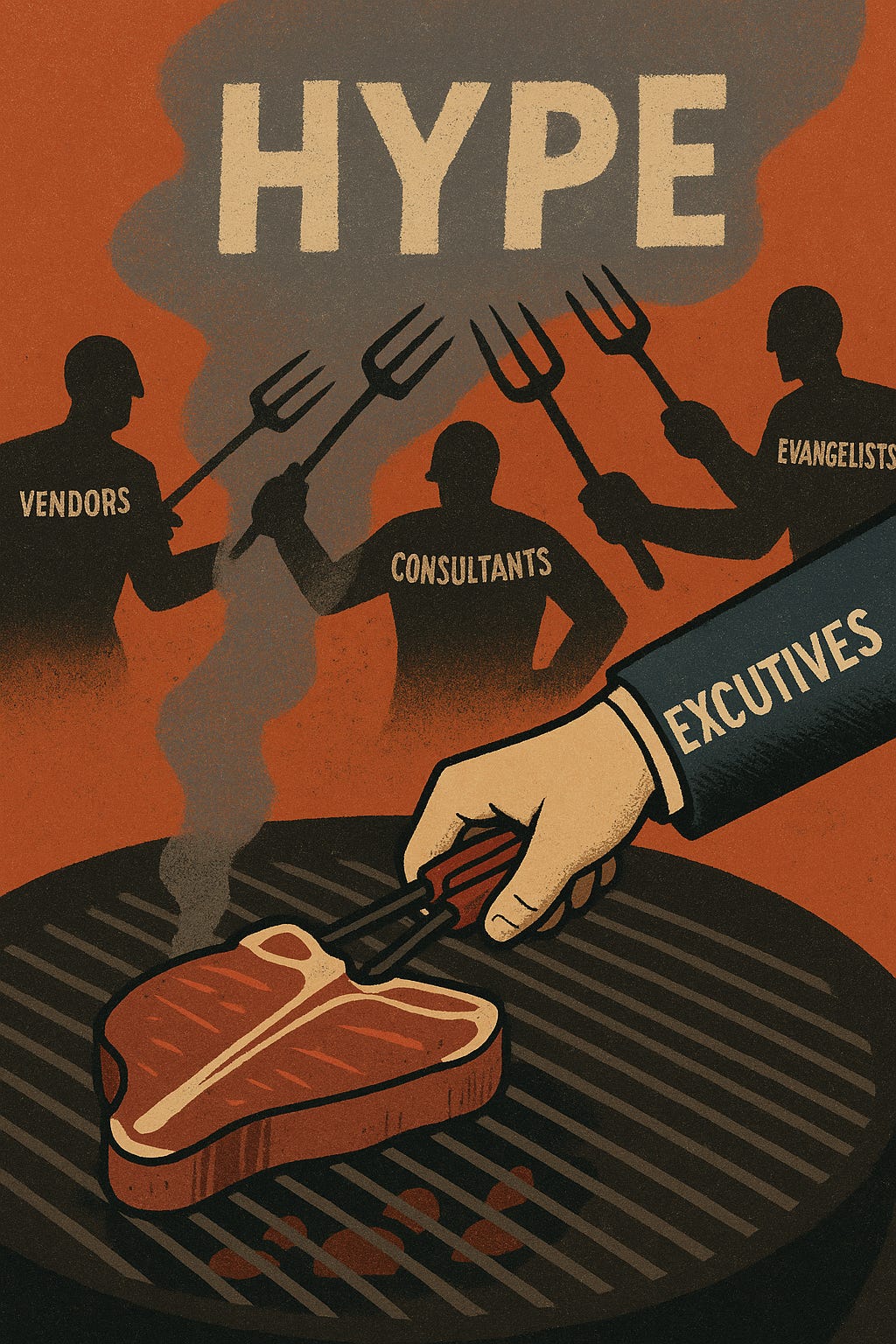From Y2K to AI: Notes From the Only Panic That Let Me Name My Price
How four lines of Perl beat a million dollars of fear, and what that says about today’s AI gold rush
They told me to pick any rate I wanted. Not “let’s negotiate,” not “what’s market,” not even a polite nod to budget. Choose any rate. That was late 1999, peak Y2K frenzy, when even the most conservative agencies were shaking quarters out of the couches. The world was supposedly a month away from digital collapse. Planes would fall. Power grids would hiccup. Payroll would revert to the Stone Age. People who had never seen a mainframe were diagnosing the end of civilization. And me? I wrote four lines of Perl and went home.
The “Y2K problem” I was handed was a perfect sample of the era. The client had a date field truncated to two digits, a batch job that refused to sort anything past December 31, 1999, and a half dozen vendors whispering disaster into decision-makers’ ears. The solution was embarrassingly simple: parse, normalize, roll forward a century when needed, reformat, done. Four lines. The hard part was not the code. The hard part was puncturing a balloon of fear fattened by sales decks.
I tell that story because the pattern is back, just dressed in black hoodies and “AI Transformation” decks instead of gray suits and COBOL estimates. AI frenzy equals Y2K frenzy. Same energy. Same breathless headlines. Same parade of consultants materializing to “de-risk” things they barely understand. Same steak-holders guarding the grill while demanding someone else buy the meat. If you’ve got money and a little anxiety about the future, someone has a plan to relieve you of both. I’m not anti-AI. I’m anti-theater. There’s a difference.
What follows is a field guide for the sanely ambitious. It’s how I think about hype cycles when I still have to ship real systems and sleep at night. It is blunt by design, because tap-dancing wastes time. If you want smoke and mirrors, the internet has a surplus. If you want results, the old rules work. They always have.
Y2K Wasn’t a Meteor. It Was a Project Plan
The hysteria made it sound apocalyptic. In reality, Y2K was mostly a bookkeeping problem. Dates were stored with two digits, those digits were about to roll, and code written for one constraint would now fail under another. A big problem? Sure. An interesting one? Not really. It was the kind of thing you fix with discipline, inventories, test harnesses, and a lot of coffee. But fear pays better than discipline, so fear took the microphone.
Organizations that had a functioning CMDB, version control with a pulse, and a culture of testing did the work and moved on. Those that didn’t scrambled, and the scramble attracted an industry of emergency fixers who billed like trauma surgeons. You either had a method or you had invoices.
Lesson one from Y2K: the real issue is almost never the headline. It’s the plumbing. The agency that let me name my price wasn’t short on intelligence. They were short on a map of their own systems and the courage to tell the board they didn’t need a moonshot, just a mop. That’s the part consultants rarely say out loud because mops don’t justify retainers. But mops keep the floors clean.
The Hype Supply Chain: Fear, Complexity, Deadline
Hype is a product. It ships on a three-lane highway: fear, complexity, and deadline.
Fear convinces you that doing nothing is reckless. It paints risk in neon.
Complexity convinces you that you need outside sherpas. It makes expertise feel magical instead of earned.
Deadline convinces you that rigorous decision-making is a luxury. It paper-cuts process until it bleeds.
Y2K had all three. Today’s AI boom has them in stereo. Replace “01-01-2000” with “your competitor just shipped an AI copilot” and “two-digit year” with “foundation model,” and the psychology is copy-paste identical. The fear is missing out rather than melting down, but the wallet opens the same way.
When fear sells, the market floods with people who know the words but not the song. They pitch “AI roadmaps” with more arrows than facts. They install pilots that generate slideware instead of savings. They write checks for training runs without asking who owns the weights, the data, or the failure modes. If you’re a founder with a demo and gall, this is a harvest. If you’re a buyer with a budget and a board, this is how you become a cautionary tale.
AI Has Real Uses. Hype Has Real Costs. Both Can Be True.
Let’s be clear. There are AI deployments that earn their keep. Triage queues that used to take two hours now take two minutes. Document-heavy workflows that chewed a day now chew a minute. Pattern recognition that humans miss gets caught. Quality goes up. Rework goes down. This is the good stuff.
But AI also loves headlines that can’t be audited. Many “wins” evaporate under measurement. Some “copilots” accelerate nonsense with confidence. Shadow costs pile up in data labeling, guardrails, red-teaming, ops hardening, and brutal edge cases. There is nothing wrong with experimentation. There is everything wrong with pretending experiments are revenue.
This is where tradition matters. The old ways still work:
Cash flow beats forecasts
Unit economics beat vibes
Observable accuracy beats anecdotes
Change management beats vendor swagger
Boring baselines beat theatrical leaps
If an AI project can’t beat a boring baseline, it doesn’t deserve a budget. That was true for Y2K remediation too. The baseline was “system still runs on January 2.” The test wasn’t eloquent. It was pass or fail.
The Four-Line Test
During Y2K I learned to ask one question before touching a keyboard: what is the minimal, brutally pragmatic intervention that proves value in a week? Not the polished platform. Not the vision thing. The smallest possible working fix. If I can’t answer that, I don’t have a project. I have a prayer.
Here’s the Four-Line Test I apply to any AI initiative. Pass all four or proceed at your own risk.
One-sentence problem statement that a CFO can repeat.
If you need a paragraph, you’re hiding the ball.A cheap baseline measured in the same units the business already cares about.
Minutes, dollars, defects, churn. Not “tokens” or “BLEU.”A reversible experiment that touches production data as early as safety allows.
Sandboxes lie. Real systems tell the truth.A kill switch on a calendar with an owner who is incentivized to use it.
If there is no planned shutdown, there is no discipline.
This is not startup poetry. It’s what prevents you from buying a very shiny rake and stepping on it.
Red Flags That Smell Like 1999
If you see any of these, clamp your wallet shut.
Hired vocabulary. People name models and hardware to signal expertise, then avoid a plain answer to “what goes up, what goes down, what gets safer, what gets cheaper.”
PowerPoint proofs. All the charts live in slides. None live in dashboards.
Pilot purgatory. Multiple months of “exploration” with no hard metric that would force a go or no-go.
CapEx theater. Big spend on GPUs before a single process changed.
Moral outsourcing. “The model said so.” If no one owns the decision, you own the liability.
Vendor time dilation. Calendars slide while invoices do not.
Data smog. Nobody can show lineage for the data used to train, evaluate, or fine-tune.
Paper privacy. Policies exist, enforcement doesn’t.
Governance busywork. Committees multiply while outcomes stall.
Evangelist turnover. The loudest internal champion leaves just as the real work starts.
These aren’t abstract. They are the exact tells that separated level-headed Y2K programs from budget bonfires.
The Steak-Holders’ Manifesto
If you hold the steak, own the fire. Wealth is not a substitute for judgment. The fastest way to get robbed in a hype cycle is to offload thinking to someone who makes money whether your project works or not.
Here’s the contract you should demand from anyone touching your AI program, including your own teams.
Put a number on the wall. One number. Tie it to something the business already values.
Name the counterfactual. What happens if we do nothing for 90 days.
Build the ugly version first. No “platform.” No “ecosystem.” The ugly version either moves the metric or it doesn’t.
Force rank the risks. Not a risk register. A top five. Every week.
Own the rollback. Write the runbook that turns it off, deletes it, and returns to last known good.
Publish the data diet. Show exactly what the system eats, where it came from, and what the licenses say.
Tie incentives to reality. Pay for outcomes, not hours. Stage-gate funding by measurable deltas.
Practice saying no. The first “no” you don’t say is the last leverage you had.
Sign that, or someone else gets the steak.
For Founders: Build for the Boring, Price for the Prosaic
A founder who wants to survive this boom will build where flashlights are dim and budgets are real. You do not need to disrupt the cosmos. You need to make a reliable dent in a line item that has survived five CFOs. If you want a non-exhaustive list of durable niches, start here:
Reconciliation, exception handling, and audit trails in legacy workflows
Claims triage and fraud hints that reduce investigation hours by half
Vendor risk review that turns three days into thirty minutes with documented accuracy bounds
Compliance mapping that shows regulators exactly what changed and why
Data-entry elimination in places everyone hates but nobody fixes
Package your value like a tradesperson, not a poet. Quote in minutes saved, dollars recovered, defects prevented, fines avoided. Publish a live ROI calculator, not a PDF. Deliver a 30-day plan, not a vision. And for the love of staying solvent, make rollback as glamorous as go-live. If you can’t reverse it safely, you don’t deserve to deploy it.
For Investors: Due Diligence That Doesn’t Get You Mugged
If you are writing checks into AI right now, the market is daring you to be lazy. Don’t be. Ask for four things before you put money in. If you don’t get them, walk.
Live dashboard showing the core metric on real customer data.
Data room with contracts, licenses, and model ownership spelled out in short words.
Customer interviews without the founder present, recorded, and transcribed.
Stage-gated milestones that release money only when units move or margins improve.
Also, translate buzzwords back into common nouns. “We do agentic orchestration” becomes “we call other software with steps a junior analyst used to do.” Then ask exactly how errors are detected, who is on the hook when the thing hallucinates, and what the blended cost per transaction is including human review. Anyone who can’t answer is not a business. They are a demo.
For Executives: Resist the Theater, Fund the Plumbing
Boards want to hear you have a plan for AI. Fine. Have one. But your first duty is to your P&L and your customers, not to LinkedIn. Fund three layers in this order.
Data hygiene and lineage. Without it, AI is a rumor.
Tight, reversible automations that improve one metric in one workflow.
Selective model bets where you own your dependency story, including vendor exit ramps.
Declare at the microphone that every pilot has a shutdown date. Publicly celebrate teams that turned projects off when results didn’t justify scale. Turn “we killed it early” into a career accelerant, not a scar. The cultures that did that during Y2K became operationally dangerous in the best way. They could do boring work under pressure without inventing dragons.
For Engineers: Do the Work That Ages Well
Hype burns. Discipline compounds. If you want to be valuable in five years, master the parts nobody wants to own.
Build harnesses that measure quality in production, not demos.
Write runbooks that a tired human can follow at 2 a.m.
Refuse to deploy anything that lacks synthetic tests and replayable traffic.
Learn to trace costs from compute to invoice so you can say, “We saved X, not we think we saved X.”
When you demo, show the ugly parts too. Trust is built in the scar tissue.
Y2K rewarded people who could inventory, test, and fix at scale. AI will reward the same. The tools changed. The work didn’t.
A Simple Buying Guide for AI, Borrowed From Y2K
This is a checklist you can run in a single meeting. Use it. It’s cheap insurance.
What breaks if we do nothing for 90 days
If “reputation” is the first word out of anyone’s mouth, slow down.What is our baseline and how do we measure it weekly
Put a number in the agenda.What is the smallest deployable slice that touches real data
If the answer is a platform, someone is upselling you.How do we reverse it on demand within 30 minutes
Show the runbook. Practice it.Who owns each failure mode
Humans always own the decision. Write that down.Where did the data come from and what do the licenses say
No vibes. Contracts.What is our exit plan from our vendors
Say the quiet part loud: dependence is a cost.When is the kill date
Put it on the calendar before you start. Bring cake if you have to shut it off.
If your vendor smiles and signs up for this, odds are they do real work. If they fidget, you are paying for theater.
The Money Question: Why Does Hype Always Win Early
Because fear is fast. Because careers get made on announcements and dissolved quietly on results. Because some investors want a story that marks up fast even if it marks down faster. Because the market consistently underprices boring competence until it is almost too late. That is why the steak-holders keep getting cooked.
The fix is not to become cynical. The fix is to become strict. Ask childishly simple questions in rooms full of jargon. Force numbers into the conversation. Celebrate reversibility. Put contracts ahead of handshakes. The loudest people do not win when the scoreboard is honest. The most disciplined do.
The Four Lines, Revisited
Back to those four lines of Perl. They weren’t clever. They were respectful. Respectful of constraints, respectful of time, and respectful of the truth that most “problems” are just untested assumptions with a PR firm. I shipped them, documented them, turned off the panic siren, and went to the next fire. Not because I’m a hero. Because that’s the job.
If today’s AI program in your shop needs a hero, stop. You don’t need a hero. You need:
A smaller problem
A clearer metric
A reversible path
A team that treats hype like background noise
I tell clients the same thing I told Y2K’s overcaffeinated committees. Your systems do not care about your feelings. They do not respond to slogans. They respond to inputs, tests, and time. Feed them well, and you will keep your customers, your money, and your sleep. Feed the hype machine, and you will keep your headlines until the invoice arrives.
The Future Is Still Built by Adults
Forward-looking does not mean gullible. The future belongs to people who can separate the real signal from the marketing echo. That is not romantic. It is accountable. It is also more profitable than any wave of panic, past or present.
So here’s my offer from a time when fear paid very well. Bring me your AI panic. I will bring a whiteboard, a stopwatch, and that Four-Line Test. If we can’t describe the problem in one sentence, beat a boring baseline, run a reversible experiment, and kill it on schedule, then we are not doing transformation. We are buying fireworks.
If we can do those things, then AI becomes what technology should be: a lever that quietly moves something heavy. No visionary posters. No breathless memos. Just work that matters, on numbers that count, by people who know why the system did what it did. That is how you make a panic pay without selling your soul or your steak.
Choose any rate? No. Choose the standard. The same one that worked when the calendar rolled and the world kept the lights on. Keep it simple. Make it measurable. Ship the smallest thing that actually helps. Turn it off if it doesn’t. Then do it again.
That is not trendy. It is adult. And it wins.
If this cut through the hype, subscribe free. If it moved a KPI, upgrade. Share with one operator who needs it.







